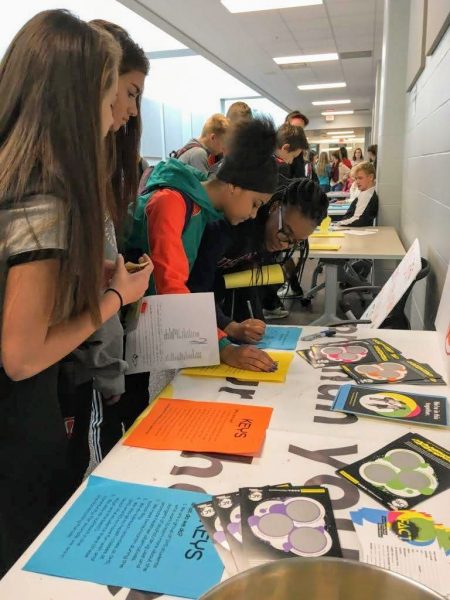I was on a conference call with the members of our program’s Youth Board a few years ago when I first learned what a hookah pen was. Still new to youth tobacco prevention, I was reading everything I could find about flavored cigarillos, little cigars and other tobacco products that kids might try. But, I didn’t learn the term “hookah pen” from the literature. I learned it from one of the high school students serving on the FACT State Youth Board.
FACT is Wisconsin’s youth tobacco prevention program. Members of FACT are in grades 7-12 and work to spread the truth about tobacco in communities throughout the state. The program is managed by the American Lung Association and we rely heavily on guidance from the program’s Youth Board. Their valuable insights help us develop informed prevention strategies that resonate with teens. Without the Youth Board it would be nearly impossible to keep up with how youth tobacco use is changing.
That high school student gave us a crucial reality check: Kids were using the term hookah pen to describe colorful e-cigarettes that looked more like a pen than a cigarette. Many of the kids trying these things didn’t realize they were actually e-cigarettes. The e-juice in devices like these is flavored like fruit, candy and other treats that appeal to kids. They don’t look, taste or smell anything like a traditional cigarette. Kids using them often have no idea they could be inhaling highly addictive nicotine and other harmful chemicals like formaldehyde and acrolein.

Because e-cigarettes aren’t regulated, there are no rules about how they’re made and no way to know exactly what is in them. Some of the chemicals that have been found in e-cigs can cause irreversible lung damage. We also know that nicotine exposure in adolescence can harm the developing brain, and youth who use e-cigarettes are more likely to go on to use other tobacco products. The aerosol that e-cigarettes produce isn’t just water vapor and it isn’t harmless.
Today, we regularly hear stories about the problem of youth e-cigarette use from Wisconsin students throughout the state. The popularity of colorful hookah pens has faded among youth in favor of sleek e-cigs that resemble flash drives. These newer devices can even be charged in a USB port. They look like an innocuous tech item that a student might store files on and they’re easy to hide in plain sight. Sometimes kids are using them right in the classroom, discreetly puffing the cloud of scented aerosol into their shirt sleeve. We initially learned about these newer devices, too, from the students on our program’s Youth Board.
Watch this video to learn more about how members of FACT are getting involved in the conversation about e-cigarettes.
To effectively address youth health issues, we need to invite youth to the table. Collaborating with youth as equal partners is the best way to learn about the realities of any issue impacting this population. Youth-adult partnerships are valuable to everyone involved. Adults gain insight into what young people are really experiencing, and youth gain skills and experience that can be transferred to life beyond school. When youth know that their thoughts are respected they are very willing to contribute. Often, all it takes is for an adult to ask what they think.
“Vaping is such a huge epidemic among Wisconsin’s teens. It started at my school a couple years ago with some kids using the big bulky types of flavored vapes, then came the hookah pens. Now the e-cigs that look like flash drives and taste like candy have become very popular with teens. E-cig use has increased rapidly at my high school. It seems like more teens are becoming addicted to nicotine by the minute. We all need to realize that vaping isn’t harmless or there will be another generation addicted to nicotine.” – Nick, Lodi High School FACT
“Many kids are using e-cigarettes at schools, especially in the parking lot and the bathrooms. I’ve seen kids post photos of themselves vaping on Snapchat and Instagram and then asking if their friends would like to buy e-cigs or e-juice from them. This is also happening on a newer app for photo-editing and social media called VSCO. It’s all over the place right in front of us. This really needs to stop.” – Alyssa, Oregon High School FACT

“We wish adults understood how e-cigs are impacting our generation. Marketing to teens is a problem with e-cigs just like it was with cigarettes for the generations before us. Because of the misleading marketing, even kids who would never consider trying other tobacco products are curious about e-cigs. The most popular e-cigs in our school look like USB thumb drives, are easy to conceal, and come in kid-appealing flavors. They’re being used in school bathrooms, locker rooms, and even during class. E-cigs are very common now and kids are becoming addicted. They’re not just water vapor and they’re not safe.” – Allie and Sammie, Wrightstown High School FACT
New data is now available that backs up what the FACT Youth Board members have been warning us about. E-cigarette use among Wisconsin youth has increased dramatically. The 2018 Wisconsin Youth Tobacco Survey found that 1 in every 5 of our state’s high school students are now using e-cigarettes. This increase is so concerning that the Wisconsin Department of Health Services recently issued a public health advisory on youth e-cigarette use.
Members of FACT groups all over our state are working to spread the truth about e-cigarettes and other tobacco products to their peers. Peer-to-peer advocacy is an effective approach to achieving social norm change. It is also important for adults to learn about this growing problem. Asking youth if e-cigarettes and vaping have become a problem at their school can be very enlightening. Also, the American Lung Association has resources on what parents should know about e-cigarettes and what schools should know about e-cigarettes. Increasing awareness of the problem and clearing up misconceptions about these products are essential steps to preventing youth tobacco use.
Renee Wadzinski is a youth program specialist at the American Lung Association and manages the FACT movement. She has earned a Master of Science in school counseling from the University of Wisconsin-Stout and a Bachelor of Arts in psychology from the University of Wisconsin-Eau Claire. She enjoys helping young people actualize their potential and make a positive impact. Watch this video to learn more about how members of FACT are getting involved in the conversation about e-cigarettes.
 The WCA Group Health Trust was created when county officials joined together to create an employee benefit program that would meet the unique needs of local governments. Today, their founding principles still remain at the core. WCA Group Health Trust is governed by officials from participating units of government and school districts, making the organization more responsive to local healthcare needs.
The WCA Group Health Trust was created when county officials joined together to create an employee benefit program that would meet the unique needs of local governments. Today, their founding principles still remain at the core. WCA Group Health Trust is governed by officials from participating units of government and school districts, making the organization more responsive to local healthcare needs.
Watertown – The Downtown Development Project
Every community has a main street - but did you know that Jefferson County is home to one of the longest in Wisconsin?...



